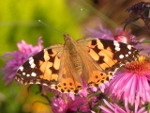The Life of a Moth or Butterfly
Author: John Published Under: Nature and Science
Moths and Butterflies are a very common type of insect, which is very well suited to surviving in extremely diverse climates. One of the most amazing things about lepidopteras, which is the scientific name for moths and butterflies, is that during their life cycle, they transform from egg, to a caterpillar, and finally grow wings and take off.
Early Life of a Lepidoptera
 The lepidoptera is born into an egg and when it is ready, cuts a circular hole in the egg, pulling itself out. It then typically eats the egg, which provides nutrients that help it survive until it can find a source of food. It is truly amazing that the hairy worm that is a caterpillar will one day become a beautiful flying insect.
The lepidoptera is born into an egg and when it is ready, cuts a circular hole in the egg, pulling itself out. It then typically eats the egg, which provides nutrients that help it survive until it can find a source of food. It is truly amazing that the hairy worm that is a caterpillar will one day become a beautiful flying insect.
In its early stages, especially when it has just emerged from its egg, the caterpillar is very vulnerable, as it makes a very appetizing snack to predators like the bird. However, they have several built in mechanisms that help protect it.
Some caterpillars look much like a twig, which helps protect and camouflage them. Others are covered in a number of hairs or even spins, which make them less appetizing targets. Most birds will not eat a hairy caterpillar, although the cuckoo is one bird that does not seem to be put off by their spines. It is not a good idea to handle hairy caterpillars, as the hair of some is poisonous and can cause a rash to develop. There are also some caterpillars that look much like a scorpion and will raise their tail when they feel threatened.
The Transformation Begins
Eventually, the caterpillar will find a limb or twig and attach create a pad made out of silk and attach its head to this pad. It then adds support for the rest of its body, using small strings of silk, which are passed around the twig or stem. Once properly supported, the skin on the back of the caterpillar will split and the pupa emerges. The pupa acts as a sort of shell, while the caterpillar transforms into a butterfly.
While the shell of the pupa is strong, it is not impenetrable, so most rely on some sort of camouflage defense, whereby the pupa will blend into the background, often looking like a dried leaf. However, some pupa are poisonous and will be very brightly colored, advertising the fact that they can not be safely eaten.
The Butterfly Emerges
 After a period of time, the colors of the butterfly will become visible under the skin of the pupa and the butterfly will emerge. The wings are almost rolled up while the butterfly is being formed in the pupa, so as soon as it emerges, it is very important that circulation occurs in the wings, otherwise they will be deformed. The butterfly will usually hang upside down and flap its wings to help promote circulation.
After a period of time, the colors of the butterfly will become visible under the skin of the pupa and the butterfly will emerge. The wings are almost rolled up while the butterfly is being formed in the pupa, so as soon as it emerges, it is very important that circulation occurs in the wings, otherwise they will be deformed. The butterfly will usually hang upside down and flap its wings to help promote circulation.
Female butterflies will lay their eggs on leaves, with some laying them on the top side and other species laying them on the bottom. To ensure that her eggs have enough food, the female will avoid leaves that already have eggs on them. With this, the cycle begins again.